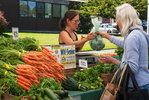In a bid to reach more customers, two of the three local farmers markets may move next year.
The Wednesday Port Townsend Farmers Market may move to the Haines Street Park and Ride or to Blue Heron …
This item is available in full to subscribers.
We have recently launched a new and improved website. To continue reading, you will need to either log into your subscriber account, or purchase a new subscription.
If you had an active account on our previous website, then you have an account here. Simply reset your password to regain access to your account.
If you did not have an account on our previous website, but are a current print subscriber, click here to set up your website account.
Otherwise, click here to view your options for subscribing.
* Having trouble? Call our circulation department at 360-385-2900, or email our support.
Please log in to continue |
|


In a bid to reach more customers, two of the three local farmers markets may move next year.
The Wednesday Port Townsend Farmers Market may move to the Haines Street Park and Ride or to Blue Heron School. Or it might just stay at its current location on Polk Street in uptown Port Townsend.
The Chimacum Farmers Market, held on Sundays, may move to a Port Hadlock location, or it may remain at its current location at 9122 Rhody Drive.
There are no plans to change the location of the large, popular Saturday Port Townsend Farmers Market. That market is at the intersection of Tyler and Lawrence streets in Uptown.
The nonprofit Jefferson County Farmers Market s(JCFM), which operates the three markets, is inviting market fans to weigh in with their opinions on the possible moves by completing an online survey at jcfmarkets.org.
In addition to trying to reach more shoppers, the potential relocations are also meant to support local farms and small businesses, and increase the sustainability of the farmers markets.
“Our goal is to explore if market moves would support community access to local food as well as growth of our markets,” said Amanda Milholland, JCFM’s market director.
PAST MOVES
The Port Townsend Saturday market has existed since 1992, the Port Townsend Wednesday market has been around since 2003, and the Chimacum market opened in 2008.
In 2003, the Saturday Port Townsend Farmers Market moved from downtown to uptown Port Townsend and opened for a second market day on Wednesdays. Milholland said one of the reasons why the Saturday market moved to Uptown was to avoid windy downtown conditions.
Each of these markets has undergone periods of development, economic hardship and growth, according to a press statement from JCFM.
When the Great Recession struck in 2008, “we saw that market also hit a decline and it hasn’t ever recovered from that decline,” Milholland said.
Milholland said the customer base has remained stable for the past three years or so, yet it hasn’t grown.
To be more successful, the markets need more vendors to attract a larger customer base.
While the Saturday Port Townsend Farmers Market is able to offer the community and its vendors a consistent, stable marketplace, the Wednesday Port Townsend Farmers Market and the Chimacum Farmers Market have decreased in size since they first opened, according to JCFM.
MORE VENDORS NEEDED
At its opening, the Wednesday Port Townsend market had about 20 consistent vendors and provided an important direct sales outlet for local farmers and artisan food makers during the week.
But the number of vendors has dropped over time to an average of seven vendors this year. JCFM stated the number of vendors declined over the years in response to low market attendance and sales.
The Chimacum Farmers Market was first opened in 2008 by the Chimacum Grange. In 2010, JCFM adopted this market and moved it to its current location at the Chimacum Corner Farmstand.
In its first years of operation at the farm stand, the market grew to serve an eager customer base. By 2017, however, sales halved for the market’s 10 or so vendors.
The Port Townsend Wednesday and Chimacum markets are operating at a loss, according to JCFM, and it is hoped that moving these two smaller markets may be the ticket to increased sales.
SATURDAY MARKET GROWING
The Port Townsend Saturday market has been thriving, with about a 1 percent growth in sales in the past year, Milholland said.
“We’re seeing with the Saturday market that, if anything, it’s growing slightly,” she said. Not by “leaps and bounds,” but consistently.
“We have between 65 and 70 vendors that participate in that market,” she said, adding that the market is recognized as one of the best in the state.
Milholland noted that the Saturday market caters to locals and visitors, while the midweek market is more of a locals’ market.
COST OF BUSINESS
The primary costs to JCFM, Milholland said, was paying for “leanship” staff, which consists of Milholland and two part-time employees.
The staff works from six to eight hours on each market day, which includes set-up time.
Additionally, there’s administrative tasks to be done behind the scenes, such as promotional work and market token reimbursement.
JCFM also pays permit fees for use of city streets and for health permits required for chef demonstrations.
Milholland said the small staff keeps costs low, which makes the markets affordable for small local vendors, allowing them to start up their businesses and experience a direct sales relationship with customers.
The farmers markets provide an important venue for vendors, Milholland said, because the profit margin can be higher than through wholesalers.
Compared to wholesale, farmers markets allow vendors to sell directly to the customers, so vendors are able to sell at a higher profit margin without charging customers more, Milholland said.
“It’s their primary place of selling their product,” she said.